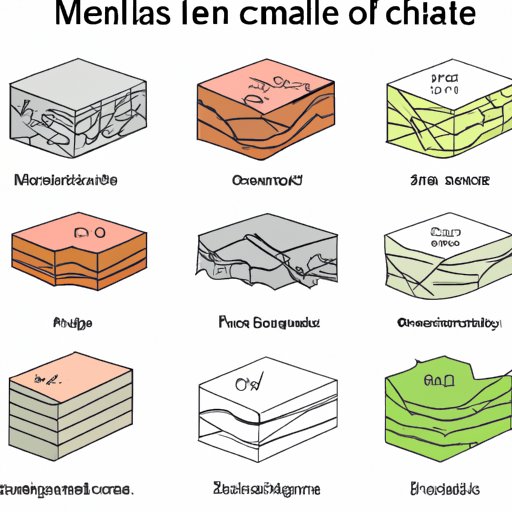Introduction
Minerals are naturally occurring substances typically composed of inorganic elements found in rocks, soils, and bodies of water. They are classified by their chemical composition and crystal structure, with over 4,000 known types of minerals existing in nature. Despite the vast number of minerals that exist, they are all composed of one or more of the 92 naturally occurring elements.
Exploring the Components of Minerals
The chemical makeup of minerals is determined by the elements that make up the mineral. Minerals are generally composed of a combination of two or more elements, such as oxygen and silicon (quartz), calcium and carbonate (calcite), or iron and sulfur (pyrite). Each element has its own unique properties and can affect the physical characteristics of the mineral, such as color, hardness, and cleavage.
Minerals can be divided into two main categories: major minerals and trace minerals. Major minerals, which include calcium, magnesium, potassium, sodium, and phosphorus, are needed in larger amounts by the body. Trace minerals, such as copper, zinc, selenium, and iodine, are required in smaller amounts but are still essential for health.
How Minerals are Formed
Minerals are formed through a variety of processes, including the action of plate tectonics, weathering and erosion, and biological activity. Plate tectonics are responsible for the formation of many minerals, such as olivine, quartz, and plagioclase feldspar. These minerals form when molten rock from the Earth’s mantle rises to the surface and cools, creating large crystals that have a characteristic shape and structure.
Weathering and erosion are also important for the formation of minerals. As rocks are exposed to wind and water, they are slowly broken down, allowing different elements to combine and form new minerals. Biological activity, such as the decomposition of organic matter, can also contribute to the formation of minerals.
Examining the Role of Minerals in Earth’s Processes
Minerals play an important role in both geological and biological processes. On a geological level, minerals help to form rocks and soil, which are essential components of the Earth’s crust. They also provide support and stability to structures and serve as indicators of changes in the environment.
On a biological level, minerals are essential for the growth and development of plants and animals. They are important components of enzymes and hormones, and they play a role in the transport of nutrients and waste products throughout the body. In addition, minerals are necessary for the formation of bones and teeth, and they are vital for normal brain function.
Conclusion
Minerals are essential components of the Earth’s crust and are important for the growth and development of living organisms. They are composed of two or more elements and can be categorized into major minerals and trace minerals. Minerals are formed through a variety of processes, including the action of plate tectonics, weathering and erosion, and biological activity. They play an important role in both geological and biological processes and have a significant impact on our lives.
(Note: Is this article not meeting your expectations? Do you have knowledge or insights to share? Unlock new opportunities and expand your reach by joining our authors team. Click Registration to join us and share your expertise with our readers.)
